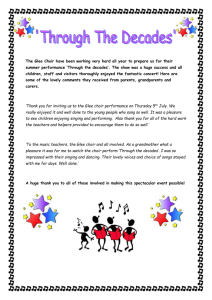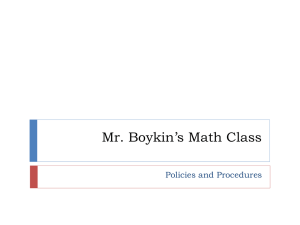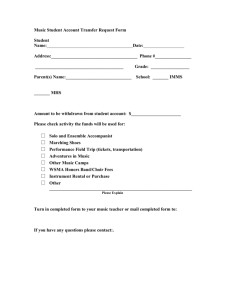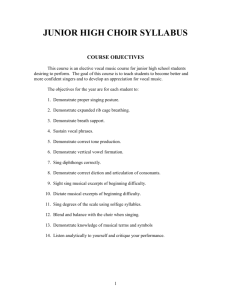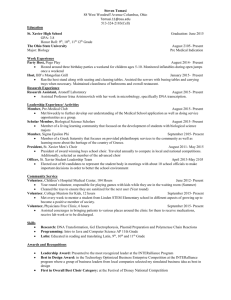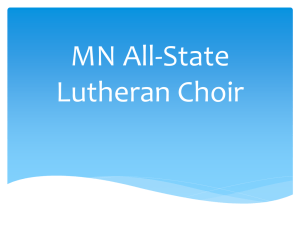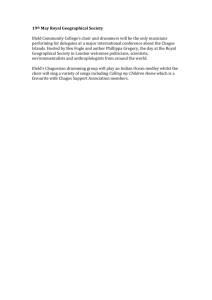Click here for a more in depth history of the Wesley Bell Ringers.
advertisement
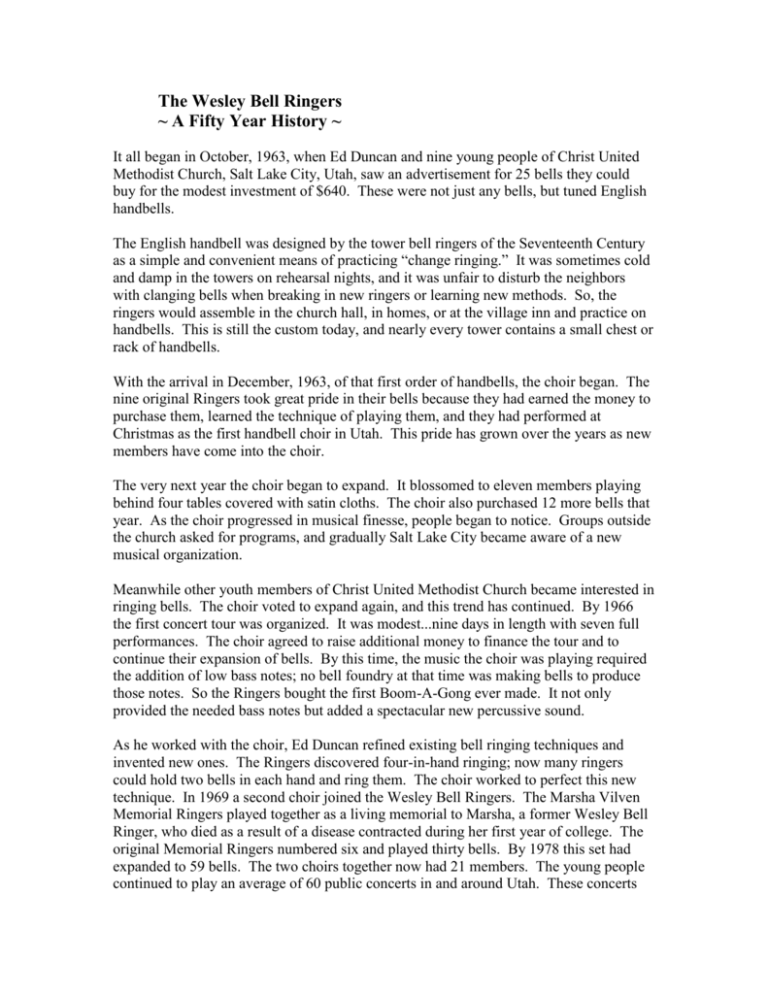
The Wesley Bell Ringers ~ A Fifty Year History ~ It all began in October, 1963, when Ed Duncan and nine young people of Christ United Methodist Church, Salt Lake City, Utah, saw an advertisement for 25 bells they could buy for the modest investment of $640. These were not just any bells, but tuned English handbells. The English handbell was designed by the tower bell ringers of the Seventeenth Century as a simple and convenient means of practicing “change ringing.” It was sometimes cold and damp in the towers on rehearsal nights, and it was unfair to disturb the neighbors with clanging bells when breaking in new ringers or learning new methods. So, the ringers would assemble in the church hall, in homes, or at the village inn and practice on handbells. This is still the custom today, and nearly every tower contains a small chest or rack of handbells. With the arrival in December, 1963, of that first order of handbells, the choir began. The nine original Ringers took great pride in their bells because they had earned the money to purchase them, learned the technique of playing them, and they had performed at Christmas as the first handbell choir in Utah. This pride has grown over the years as new members have come into the choir. The very next year the choir began to expand. It blossomed to eleven members playing behind four tables covered with satin cloths. The choir also purchased 12 more bells that year. As the choir progressed in musical finesse, people began to notice. Groups outside the church asked for programs, and gradually Salt Lake City became aware of a new musical organization. Meanwhile other youth members of Christ United Methodist Church became interested in ringing bells. The choir voted to expand again, and this trend has continued. By 1966 the first concert tour was organized. It was modest...nine days in length with seven full performances. The choir agreed to raise additional money to finance the tour and to continue their expansion of bells. By this time, the music the choir was playing required the addition of low bass notes; no bell foundry at that time was making bells to produce those notes. So the Ringers bought the first Boom-A-Gong ever made. It not only provided the needed bass notes but added a spectacular new percussive sound. As he worked with the choir, Ed Duncan refined existing bell ringing techniques and invented new ones. The Ringers discovered four-in-hand ringing; now many ringers could hold two bells in each hand and ring them. The choir worked to perfect this new technique. In 1969 a second choir joined the Wesley Bell Ringers. The Marsha Vilven Memorial Ringers played together as a living memorial to Marsha, a former Wesley Bell Ringer, who died as a result of a disease contracted during her first year of college. The original Memorial Ringers numbered six and played thirty bells. By 1978 this set had expanded to 59 bells. The two choirs together now had 21 members. The young people continued to play an average of 60 public concerts in and around Utah. These concerts were performed for churches, civic organizations and schools. A concert tour continued to be a part of each year’s program. By 1975 the choir completed its goal of performing in each of the 48 continental states. In 1979 the choir at last had the opportunity to purchase large bass bells. In fact, the largest bells ever produced by a handbell foundry became available. The Wesley Bell Ringers received the first set of these bells. As the choir grew in size and musical ability it also grew as a community. Traditions were born and developed along with the pride of membership. The choir was becoming family to its many ringers. They were being strengthened with the glow of ringing bells, raising money, and pleasing people with their music. Early fund raising projects were Rummage Sales that became semi-annual and sandwich sales. In the beginning rummage was mostly “traded” by church members, but the sale grew to be an outreach to the community, providing gently used household items at very low cost. Sandwich sales turned into semi-annual meal-in-a-bun Hoagie Sales, one of which was offered in time to provide Super Bowl Sunday lunch. The Ringers began producing record albums so listeners could have a permanent remembrance of a special concert. They recorded twelve albums. The first was made in 1966; in 1976 they recorded a Bicentennial album, and there were three Christmas albums – “Sleigh Ride,” “Holly,” and “Noel.” “Holly” was recorded in 1983 as a memorial to Holly Wald Shafer. In 1981 there were more interested ringers than available positions; it was time to expand again. The St. Cecelia Ringers were organized. The five original members of this choir chose their own name – in honor of the patron saint of music – and the choir purchased an additional set of 26 bells. In twenty years the Wesley Bell Ringers expanded from one nine-member choir with 25 bells to three choirs totaling 27 members ringing 164 tuned bronze handbells. The choir had also acquired the Boom-A-Gong, a 25-note Dutch Carillon [the original 2 octave set of Petit and Fritzen bells], a 25-note set of handchimes, 25 tuned cow bells, tone bars, miscellaneous orchestra chimes, and a 25-note set of Whitechapel cup bells. The bells range in size and weight from the smallest, weighing less than one pound, to the largest, weighing 25 pounds. Together they cover six full octaves with many notes duplicated. The choir celebrated the 20th Anniversary of The Wesley Bell Ringers in 1983 with an anniversary book giving the history and traditions of the choir in the belief that 20 years was significant and a reason to celebrate – as indeed it was. After1983 the choir continued to expand. Because the number of Ringers varied significantly from year to year, the WBRs were no longer organized into three distinct choirs. In 1984 the choir reached another touring goal when, as part of a northwest tour, the Ringers spent four days in Alaska, playing concerts in Anchorage, Eagle River, and Homer (“the End of the Road”). This required not only a plane ride but also squeezing all Ringers and equipment into a school bus for the four days. The bus was driven by a good humored but genuine “Sourdough.” Choir concerts in the 1980s and 90s featured occasional costume elements (typically hats) and two slide shows – one showing individual photos of the Ringers and the other illustrating one of the concert selections. An example of the latter was an arrangement by Ed Duncan with several pieces about bells – “Til There Was You,” “The Trolley Song,” etc. – illustrated with every kind of bell tower, carillon, trolley, school and church bell found to photograph. Many CUMC members represented loving couples under an archway of bells for the song “Til There Was You.” A second opportunity to visit Alaska during a northwest tour came in 1990. This time the choir took the Alaska Railroad from Anchorage to Fairbanks, enjoying views of Mt. McKinley, as well as a stop along the way in Denali National Park. As always when not using a tour bus, the problem of moving the choir’s ever-expanding necessary equipment arose. This time all the equipment was loaded into the train’s baggage car. Another “new wrinkle” in 1990 resulted from technology advances that now made recording 33 1/3 albums obsolete. That summer the choir recorded its first compact disk, titled “Footprints.” In 1993 the choir once again took flight, completing performances in all 50 U.S. states, when the Ringers toured and performed on the Island of Oahu, Hawaii for seven days in the midst of yet another northwestern tour. The Polynesian Cultural Center, the USS Arizona Memorial at Pearl Harbor, and beach time on Waikiki gave Ringers special memories. Over the WBR history the choir has also performed in nine out of the ten Canadian provinces as well, missing only Newfoundland. Since, as a teacher of high school physics, Ed had the same out-of-school schedule as his ringers, the choir’s summer tours under his leadership had grown to five weeks in length and alternated U.S. regions among northeast, southeast, and northwest. It became a goal for a Ringer who was at least a three-year choir member to be able to claim having visited all 48 continental states. And, of course, Ringers in 1984, 1990, and 1993 had the potential of visiting 49 or even 50 states. Ringers were not without significant learning opportunities while on tour. With the help of Ed’s wife, Trudy, a world geography teacher, choir tour manuals were created, providing each member with detailed information about each place and attraction visited. After a 5-week tour, the end-of-tour Home Concert came in July. Ringers traditionally approached this concert just as they did any other concert on the tour schedule. They arrived at CUMC on the tour bus in the afternoon, enjoyed a dinner prepared by the “host church” and didn’t connect with parents, other family members, or friends until after the concert. The Wesley Bell Ringers have performed at Disney World in Florida; The Cathedral of the Pines in New Hampshire; the U.S. Capitol in D.C.; Mount Rushmore in South Dakota; a wide variety of church denominations, and a 1989 Christmas program with the Mormon Tabernacle Choir. Several parades around the country have had Ringers marching and ringing at the same time (can you walk and chew gum?). Memorable examples are the Portland, Oregon Rose Parade, the Brainerd, Minnesota Johnny Inkslinger Parade (in honor of Paul Bunyan’s sidekick), and the Salt Lake City Santa Claus Parade. The Choir has also been the featured handbell choir (Honor Choir) at several area handbell festivals. After the Ringers returned home from tour in 1996, Ed Duncan resigned from his 33-year role as Founder/Director. He immediately became “Director Emeritus,” and a major effort to find a new director resulted in Terry Waite agreeing to try on the, by this time, VERY LARGE WBR Director shoes. Terry stepped into the leadership role in the fall of 1996. He appreciated the faithfulness of choir members who stayed with the organization in the confidence that the “show must go on.” It went on indeed, beginning with the big event of being guests of the Utah Symphony during the Christmas concert schedule that December, when Terry had been WBR Director for only three months. The change in leadership was fairly sudden, but The Wesley Bell Ringers moved forward without hesitation. A change in the summer tour duration was necessary in 1997 because Terry did not have the same vacation time as Ed. The length of the tour was scaled back from 5 weeks to 16 days, but otherwise remained the same in travel and mission opportunities. The choir recorded a second CD following the 1999 summer tour. It was titled “The Road Less Traveled.” In December, 1999 Terry led the choir in a second Christmas program as guests of the Mormon Tabernacle Choir. Tracey Slinger, a skilled music educator and violinist, started helping the choir in 1999 and was the Assistant Director from 2000 to 2012. She worked hard to make the choir “musical.” She went on tour as a chaperon and incorporated “bus games” into the days of very big mileage. Her important duties included training new ringers and helping individual sub-sections work out bell assignments and difficult musical passages. She arranged several memorable pieces including “Anvil Chorus,” “Canticle of Africa,” “Dance of the Hours,” and “Freedom Rings.” Her direction of “Italian Symphony” in 2011 was among the real “crowd-pleasers.” By 2000 the equipment of The Wesley Bell Ringers had grown to include 260 handbells, 98 handchimes, 25 Silver Melody Bells, a 25-note Petit and Fritzen Bell Carillon, 25 Whitechapel Cup Bells, 2 octaves of Chinese Saucer Bells, the Boom-A-Gong, miscellaneous orchestra chimes, tone bars, a 2-octave set of tuned cowbells, and various other percussive instruments. When summer tour plans began coming together that year, Terry invited Ed and Trudy to consider becoming Tour Chaperons...for life! They accepted the offer and have since been found on the bus each summer as the chaperons with the most hands-on experience. The arrival of the 2000 Millennium year seemed favorable for a Reunion of all former WBRs. It was a daunting task, however, requiring a 16-member organizing committee to plan and secure appropriate activities and venues and send invitations to all WBR alumni, some of whom were not easy to track down, given changes in geography and unknown married surnames. Nevertheless, a weekend three-day reunion took place at the end of June and included a picnic in Sugarhouse Park with food, games and fun for all ages, an informal gathering at church, the Home Concert and Sunday church service performance by alumni ringers. Out of a total of 352 alumni and active ringers at that time, 112 attended some or all of the reunion events. A souvenir book, “Wesley Bell Ringers Alumni, 1963-2000," was produced, giving the choir’s history, traditions, a complete list of Ringers, all current addresses and other contact information, lists of choir award recipients, and perhaps best of all, comments and photos submitted by the alumni sharing their WBR memories and updating their life stories. Spiritual support for athletes during the Olympic Games has been required of all modern Olympic competitions. So when the Winter Olympics came to Salt Lake City in 2002, the Interfaith Round Table was founded to supply that spiritual support. The Wesley Bell Ringers performed as part of the major Interfaith Round Table concert event in 2002 and continued to play a role in similar events through 2006. The Wesley Bell Ringers’ choirs consist of youth who are in 9th through 12th grades in school. Some who opt to remain for one additional year have been dubbed “Super Seniors.” Together, the high school seniors and super-seniors now play a small-group piece as part of the choir’s annual tour program, creating a new choir tradition in 2002. Rummage Sales have continued to be major fund raisers for the choir twice each year. But the extensive remodel of their CUMC home in 2004 brought a MAJOR change to those Rummage Sales. Because CUMC was sharing worship space with First Congregational Church, accommodating the huge amount of sale clothing became impossible. The lack of clothing to sort, display and clean-up was found to have many advantages, and the ban on clothing has been kept. The disadvantage for the Ringers has been the lack of opportunity to express their theatrical creativity (i.e. Dress Up!) while working the sales. Other fund raising changes followed. By 2006 the Hoagie Sale was no longer a profitable fund raiser. The project was folded for good after the last Hoagie went that year. What to do? In February, 2007 the Valentine Dinner Dance replaced the Hoagie Sale as a new era fund raiser. This event has proved very popular with CUMC members and friends. With bell parent help, the CUMC gym is transformed into a stylish dining/ballroom, and a delicious dinner is professionally served by the Ringers. “Stella,” a local band that plays very danceable contemporary jazz and rock music, has been a fixture enjoyed by all ages. In 2012 a silent auction was successfully added to this event. With this addition, the Dinner Dance truly began to raise money beneficial to the organization. A ½ octave of bass handchimes, the largest made, added low reverberating bass notes in 2008. These bass notes range from G2 to B flat 2 (that’s “handbell speak” that any current Ringer or alum will be happy to explain). As is abundantly clear, The Wesley Bell Ringers have never ceased expanding the variety, number, and range of instruments at their command. In 2010 the unexpected addition of a complete set of orchestra chimes was purchased as a memorial for Debra Duncan. Then in 2012-2013 the choir added three octaves of handbells to accommodate the growth of the choir. The encouragement to record has continued as well. In 2001 the third CD “Southbound” joined the list of WBR recordings. This was followed in 2003 by “The Liberty Tour” CD. At the end of the 2007 WBR tour, the choir recorded the “42nd Summer Concert Tour” CD, and in 2010 “Burning Bronze” became the most recent CD. Under Terry’s leadership, the WBR have continued to use props, costumes, slideshows and solo work by Ringers skilled in vocal or instrumental performance. His choirs have performed at the Old South Church in Boston, Massachusetts; Disney World in Florida; Mount Rushmore in South Dakota; the Cathedral of the Pines in New Hampshire; and have been the invited Honor Choir at area handbell festivals. Summer tours have again visited all 48 states and most of the Canadian provinces. For The Wesley Bell Ringers 2013 summer tour, the choir boasted the largest number of members ever. There were 37 in the choir -- 19 male and 18 female members. The northeastern U.S. tour schedule included Ohio, Pennsylvania, Connecticut, Maine, Vermont, Massachusetts, and New York. The culmination was a widely publicized tourreturn concert in Abravanel Hall having, as has been customary for Home Concerts, no admission charge. This concert was the centerpiece of a grand Reunion Weekend. All 458 alumni and current ringers, plus present and past tour chaperons, were invited to celebrate the 50th anniversary with a gathering of good friends from yesterday or years long past, this book of Wesley Bell Ringer photos and memories, and a spectacular public concert. The event was designed as a fitting 50-year celebration of a unique organization of youth engaged in music education and performance, spiritual growth and development, and outreach in love to their audiences everywhere.
